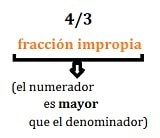In order to know the meaning of the term improper fraction, it is necessary, first of all, to discover the etymological origin of the two words that give it its shape:
-Fraction, first of all, comes from Latin. Exactly it derives from “fractio, fractionis”, which can be translated as “broken piece” and which derives at the same time from the verb “frangere”, which is synonymous with “break”.
-Improper, secondly, we have to emphasize that it also emanates from Latin. In his case, from “impropius”, which can be translated as “that does not belong to the characteristics that correspond to a person or thing.” A word that is the result of the sum of several lexical components, such as the following: the prefix “in-”, which means “not without”; the word “pro”, which is synonymous with “in favor”; the adjective “privo”, which is equivalent to “private”; and the suffix “-io”, which is used to indicate “result” or “effect”.
A fraction is an expression that refers to division . It is made up of two numbers separated by a dividing line: the numerator (which appears above this line) is the number to be divided, while the denominator (which appears below the line) is the quantity by which it is divided.
 Let's see an example . 5/8 is a fraction that has the number 5 as the numerator and the number 8 as the denominator. In this case, the fraction indicates the division of 5 into 8 : 0.625 .
Let's see an example . 5/8 is a fraction that has the number 5 as the numerator and the number 8 as the denominator. In this case, the fraction indicates the division of 5 into 8 : 0.625 .
Depending on their characteristics, we can classify fractions in different ways. An improper fraction is one whose denominator is less than its numerator . Therefore, the fraction is greater than 1 . On the other hand, when the denominator is greater than the numerator, we are dealing with a proper fraction , which represents a number greater than 0 but less than 1 .
Taking this explanation into account, we can affirm that 4/3 , to cite one case, is an improper fraction. Its numerator is 4 and its denominator is 3 : as you can see, the numerator is greater than the denominator. If we solve the division , we will notice that the result is greater than 1 : 1.33 .
Sometimes the numerator is much larger than the denominator . This is the case of fraction 5872/4 . The numerator ( 5872 ) is 1468 times larger than the denominator ( 4 ), as we discovered when we did the division.
8/3, 54/7, 581/29, 892/431 y 182530/51779 son otras fracciones impropias. La condition es siempre la misma: que el numerador sea mayor que el denominador o, dicho de otro modo, que el denominador sea menor que el numerador. Cuando se cumple esta propiedad, la fracción recibe la denominación de impropia.
In addition to everything indicated, we cannot ignore that improper fractions have the peculiarity that they can be converted or represented by a mixed number, that is, as a natural number plus a proper fraction.
In order to be able to represent an improper fraction in this way, the process that must be followed is to divide the numerator by the denominator. The quotient that remains will be the natural number while the remainder will be the numerator of the proper fraction.
